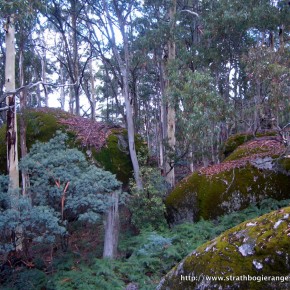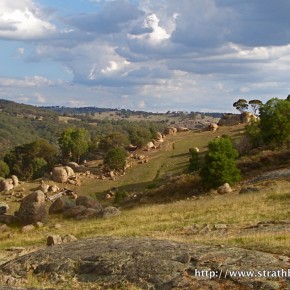View recent posts relating to Rocky Outcrops here
Fence them out and let them recover
We have funding available until July 2013 for fencing and habitat protection/rehabilitation, for all the different types of rocky habitat in the Strathbogie Ranges CMN area. However, as funds aren’t unlimited, we’re initially looking at sites of about 0.5 ha and above. A fencing subsidy of between $5/m and $7/m (depending on site size and quality) is available for eligible sites and establishment, or rehabilitation of native vegetation is also subsidized.
For more information contact either Janet, Bert or Jenny and get the ball rolling
Rocky Outcrops are special places

There’s something special about big, mossy boulders, rugged gorges and rocky escarpments. Rocky habitat comes in many varieties: isolated boulders, tors and boulder-heaps, rock domes and smaller scattered rocks on the ground surface. And these different rocky habitats can occur in association with different vegetation types and landscapes; near creek-lines, at the bottom of steep slopes, on ridges and peaks. Regardless of where they occur, they are important habitats for many different plants and animals that have become specialized at surviving in this environment.
Although rocky outcrops are perhaps less susceptible to stock damage than streams and wetlands, they have nevertheless suffered from clearing and then set-stock grazed. Most stock like to camp somewhere with a view and this often leads to loss of protective soil cover, fouling by large amounts of manure and then weed invasion.
Luckily, in many areas rocky ground and boulders have kept stock out and protected the native vegetation from destruction, or degradation. Its these still-intact rocky habitats that urgently need protecting and the easiest management tool, as with most land management issues, is fencing.

Not only are rocky sites home to specialized, often unique species, but healthy rocky sites play a hidden, yet very important role in the water-cycle of the Strathbogie Ranges. In the Ranges, we place great value on groundwater. Its groundwater that supplies your spring-fed dam, perched bog wetland, domestic and irrigation bore and that keeps streams running throughout the year. But where does this water come from? It originally fell as rain and then soaked into the ground, but the only place rainfall can get deep enough into the ground to become groundwater, is in and near elevated rocky sites. Here, the cracks and fractures in rock at or close to the surface allows water to ‘recharge’, to seep deep into the underground ‘fractured rock aquifers’ that hold the water, then release it over the course of months and years.
So, there’s a very direct link between the elevated, often dry, harsh, rocky recharge areas and the wet, boggy, or riparian discharge areas. Importantly, rocky sites in natural areas allow rain to get into the groundwater more quickly and effectively, because plant roots and soil biology keep the surrounding and overlying soil loose and friable. Rocky sites that lack native vegetation, especially shrubs and trees, usually have compacted soil (from stock) and tend to shed water more quickly than it can filter down into the rocky ground. Bare rocky slopes and hills suffer from high risk and rates of erosion (water and wind), often cause more problems that they are worth and are usually uneconomical.
Rocky slopes and hills clothed by native vegetation are an overwhelming asset to the land.
